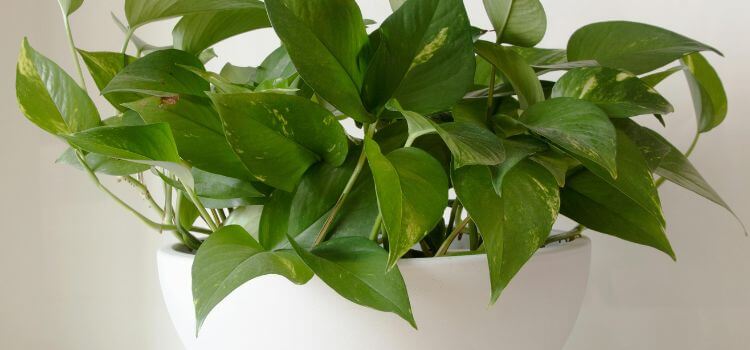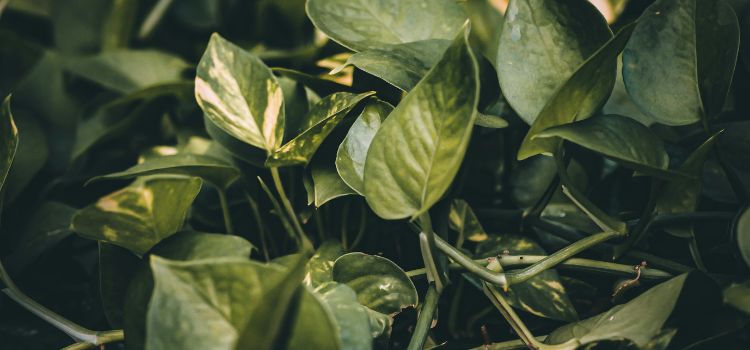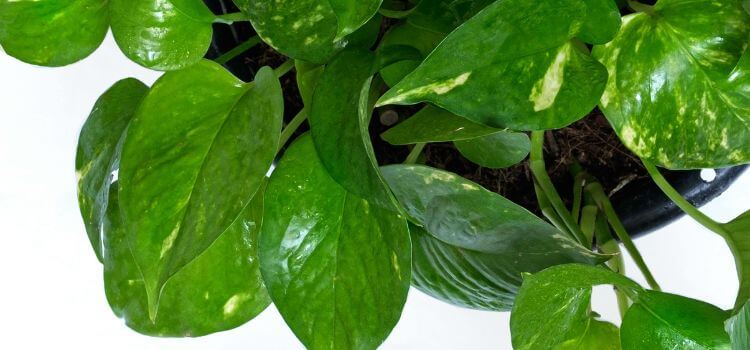As an Amazon Associate, I earn from qualifying purchases.
Provide bright, indirect sunlight and regular fertilization to make Pothos leaves bigger. Ensure proper watering and pruning for optimal growth.
Pothos plants, known for their lush green leaves, thrive with the proper care. Bright, indirect sunlight is essential for their growth, helping leaves grow larger. Regular fertilization supplies necessary nutrients, promoting bigger and healthier foliage. Watering consistently but not excessively keeps the roots hydrated and prevents leaf damage.
Pruning, a simple yet effective technique, stimulates bushier growth, leading to more substantial leaves. By providing the right care, you can transform your Pothos into a vibrant, attractive plant, elevating the aesthetics of your indoor spaces. With these straightforward steps, you can unlock the full potential of your Pothos, unveiling larger, more impressive leaves.
Pothos Plant
Pothos, also known as Epipremnum aureum, is a popular houseplant. It is loved for its vibrant, lush leaves and ease of care. To grow more giant leaves, it’s essential to understand the plant’s nature and needs.
Characteristics Of Pothos Plant
Pothos plants have heart-shaped leaves that can vary in color. They range from deep green to variegated patterns. These plants are known for their trailing vines. They can grow several feet long. Pothos can also climb when given support.
- Low maintenance: Perfect for beginners.
- Air purifier: Helps clean indoor air.
- Versatile: Can be grown in water or soil.
Ideal Growing Conditions For Pothos
| Condition | Optimal |
|---|---|
| Light | Bright, indirect sunlight |
| Temperature | 65-85°F (18-29°C) |
| Humidity | Moderate to high |
| Soil | Well-draining potting mix |
| Watering | Water when soil feels dry |
Ensure these optimal conditions are met for more giant leaves. Healthy Pothos plants will naturally produce more significant, more vibrant leaves.

Factors Affecting Leaf Size
Pothos plants are famous for their lush, trailing vines and vibrant leaves. Understanding the factors that influence leaf size is essential to make Pothos leaves bigger. These factors include light intensity and quality, nutrient availability, pot size, and root-bound conditions. Paying attention to these elements can help you grow larger, healthier leaves.
Light Intensity And Quality
Light intensity and quality play a significant role in leaf size. Pothos plants thrive in bright, indirect light. Too much direct sunlight can scorch the leaves, while too little light can cause smaller, paler leaves. Placing your Pothos near a window with filtered sunlight or using grow lights can help achieve optimal light conditions.
- Bright, indirect light is ideal.
- Avoid direct sunlight to prevent leaf burn.
- Consider using grow lights in low-light environments.
Nutrient Availability
Pothos plants require adequate nutrients to produce larger leaves. To ensure your plant gets the necessary nutrients, fertilize it regularly. A balanced, water-soluble fertilizer every 4-6 weeks during the growing season can help. Pay attention to signs of nutrient deficiency, such as yellowing leaves, and adjust your fertilization routine accordingly.
| Fertilizer Type | Frequency | Application Method |
|---|---|---|
| Balanced, water-soluble | Every 4-6 weeks | Diluted in water |
| Slow-release granules | Every 2-3 months | Sprinkled on soil |
Pot Size And Root Bound Conditions
The size of the pot and root-bound conditions can affect leaf growth. A pot that is too small can restrict root growth, leading to smaller leaves. Report your Pothos into a larger container when you notice roots growing from the drainage holes. Choose a pot that is 1-2 inches larger in diameter to give the roots room to expand.
- Check for roots growing out of drainage holes.
- Repot in a larger container.
- Ensure the new pot has proper drainage.
Proper pot size and avoiding root-bound conditions will promote healthy leaf growth.
Pruning And Training Techniques
Pothos plants are beloved for their lush, trailing vines and heart-shaped leaves. If you want to make your Pothos leaves bigger, employing pruning and training techniques can be a game-changer. These methods not only encourage healthier growth but also help in achieving more significant, more vibrant leaves. Let’s dive into the specifics of pruning and training your Pothos for optimal leaf size.
Nodes For Pruning
Nodes are crucial points on the stem where leaves and roots grow. Pruning at the right nodes can stimulate new growth and lead to larger leaves.
- Locate the nodes: Find the tiny bumps or swellings along the vine. These are the nodes.
- Use sharp scissors: Cut just above a node to encourage new growth.
- Promote bushier growth: Pruning at nodes will help your Pothos grow bushier and healthier.
Frequent pruning keeps your Pothos plant vibrant and encourages larger leaves.
Encouraging Aerial Root Growth
Aerial roots absorb moisture and nutrients from the air, aiding in the plant’s overall growth. Encouraging these roots can significantly enhance leaf size.
- Maintain humidity: Keep the environment humid to support aerial root growth.
- Use a moss pole: Attach a moss pole to provide support and moisture for aerial roots.
- Spray the vines: Regularly mist them to keep them moist and encourage root development.
Proper care of aerial roots will result in a healthier plant with more giant leaves.
Training Vines For Increased Leaf Size
Training your Pothos vines can direct energy towards leaf growth, resulting in larger leaves.
| Training Method | Description |
|---|---|
| Trellis | Use a trellis to guide the vines upward, promoting larger leaf growth. |
| Horizontal Training | Lay the vines horizontally to encourage leaf expansion along the length. |
Consistent training techniques ensure your Pothos grows with more giant, impressive leaves.
Soil And Fertilization Tips
One of the secrets to growing large, lush Pothos leaves lies in the soil and fertilization. Proper soil and feeding routines are crucial for healthy growth. Below, we delve into the best soil mix and fertilization practices to help your Pothos thrive.
The Right Soil Mix
The right soil mix is vital for Pothos plants. Well-draining soil is essential. It prevents water from pooling and rotting the roots. A blend of potting soil, perlite, and peat moss works well. This combination ensures good aeration and moisture retention.
Avoid dense soils that can suffocate the roots. Check the soil’s pH level too. Pothos prefer a slightly acidic to neutral pH (6.1 to 7.3). You can use a simple pH tester to monitor the levels.
Consider adding organic matter like compost. It enriches the soil and promotes healthy root development. Your Pothos will thank you with more giant leaves.

Fertilization Schedule And Nutrient Balance
Regular fertilization is critical to promoting large leaves. Use a balanced liquid fertilizer, like a 20-20-20 formula. It provides essential nutrients in the proper proportions.
Follow a consistent fertilization schedule. Feed your Pothos every 4-6 weeks during the growing season (spring and summer). Reduce feeding in the fall and winter when growth slows down.
| Season | Fertilization Frequency | Fertilizer Type |
|---|---|---|
| Spring | Every 4 weeks | Balanced liquid fertilizer |
| Summer | Every 6 weeks | Balanced liquid fertilizer |
| Fall | Once | Slow-release fertilizer |
| Winter | None | None |
Make sure to dilute the fertilizer to half-strength. Too much fertilizer can burn the roots and stunt leaf growth. Constantly water the plant before and after fertilizing. It helps distribute nutrients evenly.
Observe your plant for signs of nutrient deficiency. Yellow leaves can indicate a lack of nitrogen, while pale leaves may suggest a need for iron. Adjust your fertilizer type if necessary.
Following these soil and fertilization tips will make your Pothos grow more prominent, healthier leaves. Happy planting!
Watering And Humidity Management
Proper watering and humidity management are crucial for making Pothos leaves bigger. Consistent care ensures your plant thrives. Both watering frequency and humidity levels play a vital role.
Frequency And Techniques
Watering Pothos is essential for leaf growth. Overwatering or underwatering can harm your plant. Follow these simple tips to get it right:
- Check the soil: Always check the soil before watering. Stick your finger 1-2 inches into the soil. If it’s dry, it’s time to water.
- The water gurgles: The water reaches the roots. Water until it drains out of the pot’s bottom.
- Using room-temperature watepot’sld water can shock the roots. Let tap water sit for a few hours before using it.
- Consistent schedule: Water your Pothos once a week. Adjust based on the plant’s needs and environment.
Humidityplant’sl For Optimal Growth
- Pothos plants love humidity, which promotes more giant leaves. To manage moisture effectively, Mist the leaves every few days with a spray bottle filled with clean water.
- Humidity trays: Place a tray filled with water and pebbles under the plant. As the water evaporates, it increases humidity around the plant.
- Grouping plants: Place your Pothos near other plants. Plants release moisture, creating a more humid environment.
- Humidifier: Use a humidifier in the room. This ensures consistent humidity levels.
Proper watering and humidity management are vital to growing bigger Pothos leaves. Follow these tips and watch your plant flourish.
Pest And Disease Prevention
Keeping your Pothos healthy is crucial for making its leaves bigger. Pests and diseases can hinder growth and damage the plant. Here, we will discuss common pests and preventive measures against diseases.
Common Pests Affecting Pothos
Several pests can affect your Pothos plant. Spider mites, mealybugs, and aphids are the most common. These pests suck the sap from the leaves, causing them to turn yellow and wilt.
- Spider Mites: Tiny, red, or brown, often found under the leaves.
- Mealybugs: White, cotton-like masses found on the stems and leaves.
- Aphids: Small, green, or black insects that cluster on new growth.
Preventive Measures Against Diseases
Diseases can also affect Pothos plants. Root rot and leaf spot are common issues. Taking preventive measures can help keep your plant healthy.
| Disease | Preventive Measures |
|---|---|
| Root Rot | Ensure proper drainage.Avoid overwatering. |
| Leaf Spot | Keep leaves dry.Improve air circulation. |
Regularly inspect your Pothos for signs of pests and diseases. Early detection is vital to preventing the spread and damage. To treat infestations, natural pest control methods, such as neem oil or insecticidal soap.
Monitoring Growth Progress
To achieve more giant pothos leaves, keeping a close watch on their growth progress is essential. This helps you understand what adjustments must be made for optimal leaf size. Let’s delve into how you can effectively monitor your pothos plant.
Tracking Leaf Development
Start by tracking the size and number of new leaves. Use a ruler or measuring tape to measure leaf length and width. Record this data in a notebook or a digital spreadsheet.
Create a simple table to log your observations:
| Date | Leaf Length (cm) | Leaf Width (cm) | Notes |
|---|---|---|---|
| 01-01-2023 | 5 | 3 | New leaf |
| 01-15-2023 | 6 | 3.5 | Healthy growth |
Review your data every two weeks to spot any growth trends. This will help you understand how your care regimen impacts leaf size.
Adjusting Care Regimen Accordingly
Based on your observations, you may need to adjust your care regimen. Consider these adjustments:
- Increase light exposure: Move your plant closer to a window or use grow lights.
- Enhance soil nutrition: Use a balanced fertilizer every two weeks.
- Optimize watering schedule: Ensure the soil is moist but not soggy.
If you notice slow growth, try the following:
- Check for pests: Inspect leaves and stems for any signs of insects.
- Prune old leaves: Remove any yellow or damaged leaves to direct energy to new growth.
- Repot if necessary: Ensure the roots have enough space to grow.
Regularly adjusting your care regimen based on growth data helps you achieve bigger and healthier pothos leaves.

Frequently Asked Questions
Provide bright, indirect light for your Pothos. Use well-draining soil and water when the top inch is dry. Fertilize monthly during the growing season. Regularly prune to encourage bushier growth. Ensure high humidity for optimal leaf size.
Small pothos leaves often result from insufficient light, improper watering, or lack of nutrients. Ensure bright, indirect sunlight, regular watering, and balanced fertilization. Pruning can also encourage larger leaves.
Increase leaf size by providing adequate water, balanced fertilizers, and sufficient sunlight. Use organic compost and avoid over-pruning.
To increase money, plant leaf size should be increased, indirect sunlight and water should be provided regularly, and a balanced fertilizer should be used. Ensure well-draining soil and prune occasionally for bushier growth. Maintain consistent humidity levels and avoid overwatering.
Conclusion
With the right care, achieving bigger Pothos leaves is simple. Ensure proper lighting, watering, and nutrient-rich soil. Regular pruning and repotting also help. Follow these tips for lush, vibrant foliage. Your Pothos will thrive and become a stunning addition to any indoor space.
Happy gardening!

